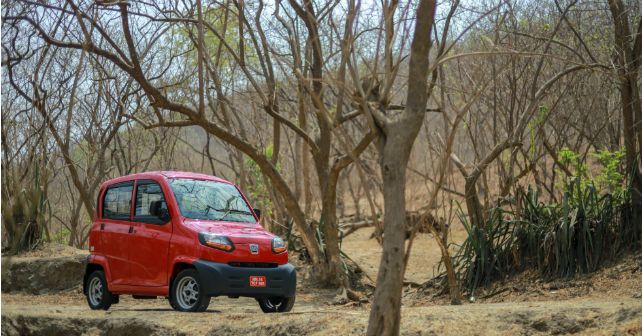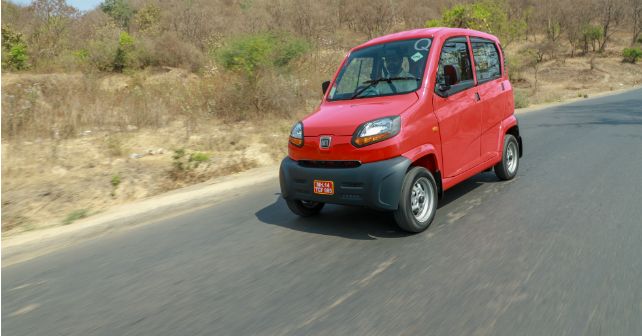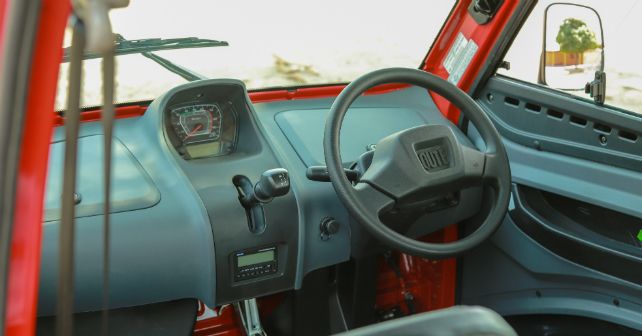
After seven long years of controversy and debate, Bajaj has finally gotten the approval to launch the Qute – India’s first quadricycle. We take it for a spin to find out what all the fuss is about.
Innovation and advancement have always been at the core of everything that Bajaj does as an automotive brand. And a quick look at its history is enough to prove that. From partnering with Kawasaki and introducing DTS-i & Triple Spark, to bringing KTM into India, Bajaj has always excelled in taking the game to the next level. But, like most things in the world, it hasn’t always been easy. But, despite various obstacles, the Chakan-based manufacturer has managed to evolve into a formidable force in the Indian automotive space. The Qute, if nothing else, is a testament to this resolve.
First showcased in 2012 as the RE60 concept, the Qute, although near production-ready, wasn’t allowed to be launched citing safety concerns. Interestingly, the vehicle was given the green light in the European Union and received the European Whole Vehicle Type Approval certification. Objections from three-wheeler unions and the competitors impeded the launch of the Qute. The company, however, didn’t succumb to the pressure and continued to push through based on the merits of its case. Eventually, last year, the Ministry of Road Transport and Highways (MoRTH) approved a new class of vehicle – the quadricycle. So, finally, say hello to the Bajaj Qute!
What is a quadricycle?
In simple terms, a quadricycle is a bridge between a three-wheeler and a conventional small car. According to the newly established norms in India, any four-wheel vehicle with a kerb weight of less than 475kgs, which passes the mandatory safety and crash tests, can be classified as a quadricycle. The vehicle can be powered by petrol, diesel or any alternate fuel, like CNG and LPG. Of course, it must clear emission norms as well. The Qute fulfils all these criteria and has been approved not just for commercial use but also as a personal mobility vehicle.
Qute-ness overload
Now that you have a fair understanding of the history of the Qute, let’s get to what makes it cute. To start with, its petit dimensions – the Qute is 2,752mm long, 1,312mm wide and 1,652mm tall. It’s curved edges – from the roof and bonnet to the headlight and bumpers – give it a toy-car-like appearance, but in a good way. Bajaj has given it a few creases along the sides that work well to break the otherwise monotonous profile. To ensure that the Qute is within the 475kg limit, and yet passes the required crash tests, a smart combination of sheet metal and plastic has been used for the body.
Inside, the Qute puts functionality over form. The dashboard is simple, with two lockable storage compartments on both sides and digital instrumentation in the centre. Bajaj has also fitted the Qute with a basic music system, which does come with a remote, USB and AUX connectivity. Aside from this, the Qute doesn’t really get much in terms of features, not even an air-con. It does, however, get two vents for the front passengers to channel fresh air in from ducts above the front bumper. Bajaj is also developing a sleek fan that will be fitted on the roof in a future update.
In the interim, users are sure to find the need for a small aftermarket fan in the cabin. Coming to the storage, aside from the front two storage spaces, there’s also space to store up to 20 kilos of luggage under the bonnet. And, if you still need to carry more, the rear 60:40 split bench can be folded down to uncover almost 400-litres of luggage space.
Space is surprisingly good for a vehicle this small. Only the driver gets an adjustable seat, which only moves fore and aft – it doesn’t recline and isn’t height adjustable either. During my time in the car, I mean ‘quadricycle,’ I had the driver’s seat pushed all the way back, and there still was a couple of inches of knee room at the back. My biggest grouse, however, was ingress and egress for rear-seat passengers. Owing to the small size of the door and the side panel, large passengers will really need to squeeze their way in.
At its heart
The Qute is powered by a 216.6cc, single-cylinder, twin-spark, four-stroke motor that’s available in both petrol and CNG variants. The former develops 13bhp and 18.9Nm. We got a chance to sample the CNG trim that pushes out a marginally lower output of 10.8bhp and 16.1Nm. This engine has been paired to a 5-speed transmission. It’s a sequential shifting gearbox, so, just like a motorcycle, you push the gear lever upwards to shift up and down to shift down.
Given that the Qute makes just about as much power as a 125cc two-wheeler, I had my reservations about the engine’s ability to propel it. But, to my surprise, it did really well for its intended application. Since the quadricycle is aimed at addressing urban mobility issues, we restricted our drive, for the most part, to within city limits. It gains momentum cleanly and definitely feels quicker than an auto-rickshaw.
The gearbox does feel a bit mechanical and rubbery to shift – something that can get a bit cumbersome in stop-and-go traffic. That being said, short gearing in the first two gears makes the Qute impressively easy to drive in slow-moving traffic. In line with the quadricycle norms, the Qute’s top-speed is limited to 70km/h – a speed it can only achieve on a reasonably long stretch of open road.
We got a chance to sample an auto-rickshaw before we drove the Qute, and I must say that the difference, in terms of ride, handling and stability is stark. Of course, the suspension has an important part to play here. At the front, the Qute has independent suspension, with a twin leading arm, while at the rear, it has independent suspension with a semi-trailing arm.
The Qute rides well over uneven surfaces and mild undulations. It’s only when the going gets really rough that it starts to send signals to the occupants inside. Two more aspects that need to be mentioned here are the fact that the Qute doesn’t come with power steering or disc brakes. However, after spending a few hours behind the wheel, we didn’t find the need for these features.
Where does it fit?
The Qute quadricycle can be sold for commercial application, as well as individual use – Bajaj’s focus, however, will be on the former. Will the Qute replace the auto-rickshaw then? For all practical purposes, it should. Of course, the transition will take a while, but it’ll be hard to ignore the obvious advantages it brings to the table.
The Qute is a safer means of mobility, not just in terms of crash protection but also when you take into account our weather conditions. It has better luggage carrying capacity. It’s efficient. And, most importantly, it’s pocket-friendly. While all these are enough reasons for it to make it in the commercial space, at `2.63 and `2.83 lakh – for the petrol and CNG variants respectively – it’s priced a little too close to a ‘regular’ car to be taken truly seriously.
Also Read:
Bajaj reveals its four wheeler - the RE60
Bajaj to export Qute, awaits Supreme Court verdict for India launch
- Bajaj Qute
Engine: 216.6cc / Single-Cylinder/ Liquid-Cooled / 4-Valve
Fuel: CNG
Transmission: 5-Speed Sequential Manual / Rear-Wheel Drive
Power: 10.8bhp @ 5,500rpm
Torque: 16.1Nm @ 4,000rpm
Price: ₹2.83 lakh (ex-showroom)
X-Factor: Increased stability, comfort and space make it an ideal alternative to an auto rickshaw.
| Pros | Cons |



























Write your Comment